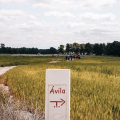With very few exceptions, the Gospels show Jesus walking through Galilee on foot. A hiking trail runs through the places that the biblical text says that Jesus visited, offering the opportunity to connect with the people who, even today, live along that path – the Jesus Trail: four days of walking through some of the most important places in the life of Jesus, from Nazareth to Capernaum.
Maoz Inon and David Landis are the founders of this singular path – a path that wants to foster hospitality in a land that is marked, today as yesterday, by deep religious, political, and social differences.
The route begins at the Church of the Annunciation in Nazareth – a city whose population, mostly Arab, is divided into 60% Muslims and 40% Christians. It goes further north to the ruins of Tzipori, the “Pearl of Galilee,” an important Late Antique Roman administrative center that, while not explicitly named in the gospels, is recognized in some ancient Christian traditions as the possible birthplace of Mary, the mother of Jesus.
Almost 6 kilometers west of Tzipori, and crossing Mashhad (the birthplace of the prophet Jonah, according to the Hebrew Bible), you arrive at Cana de Galilee. According to the Gospel of John, the first miracle of Jesus took place here: the conversion of water into wine at the wedding of some unforeseen bride and groom.
The second day of the trek leads from Cana to Kibbutz Lavi, some 15km north of Mount Tabor – the site of the Transfiguration of Jesus and the battle between Barak and Jabin’s army, commanded by Sisera.
On the third day, the difficulty increases, but the scenery is well worth the effort. That’s what the crusaders must have thought when they crossed the area for the last time –only to be crushed by Saladin in the decisive battle of Hattin. Near that place is Nebi Shu’eib, the place where the Druze (al-Muwahiddün) is buried the father-in-law of Moses, Jethró (called Shu’eib in the Druze tradition), to whom special veneration is professed.
A few kilometers further up a slope you will reach the cliffs of Mount Arbel. From them you can see the Sea of Galilee – one of the privileged places of the life and ministry of Jesus, according to the gospels.
Descending from Mount Arbel, the path leads to Migdal (the biblical Magdala), the city that tradition recognizes as the birthplace of Mary Magdalene (or, at least, the town she lived in). In the archaeological park of Migdal we find the remains of an exceptional synagogue in which tradition affirms that one of the healing miracles of Jesus narrated in the synoptic gospels took place – the healing of the man with the withered hand.
The next place on the route is Kibbutz Ginosar. There, in the 1980s, a fisherman’s boat from the 1st century was recovered. Reaching the end of the road the places that appear again and again in the gospels follow one another: Tabgha, the place of the multiplication of the loaves; the Mount of Beatitudes; and Capernaum, Peter’s hometown, where Jesus lived until almost the end of his public life.
The Jesus Trail, however, does not end here. There are still many other possible, successive developments –all of them strictly Gospel-based. To give just two examples, a few kilometers from Capernaum one finds Betsaida. According to Theodosius’ De Situ Terra Sanctae, Byzantine pilgrims came to Bethsaida to visit the hometown of the apostles Peter, Andrew, Philip, and the sons of Zebedee, John and James. If you go around the lake from the east, you will reach the archaeological complex of Kursi – the ancient Gerasa, the scene of the exorcism of the Garasene demoniac narrated in the three synoptic gospels.
For Inon and Landis, the current Jesus Trail is just the beginning. “We firmly believe that tourism and interaction between people can create a better future for everyone: for those of us who live here now, and for the people who will live here in the future. Tourism is the world’s largest industry: it generates 10% of world’s GDP. And if we can channel it in a positive way, a way that creates a shared interest between different communities and nationalities, it can create a huge positive impact.”




